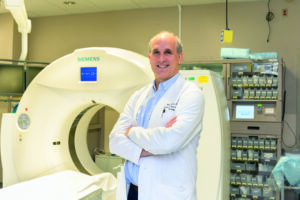
Minimally invasive and image-guided immunomodulation may transform local into systemic treatment through the multidisciplinary combination of drug plus device plus imaging guidance says Bradford J Wood (Bethesda, USA), speaking on immunotherapy in interventional oncology or ‘IO in IO’.
What a cool time to be in interventional radiology (IR) and IO! An avalanche of immunomodulation locally delivered by interventional radiologists may soon dwarf all other indications for IO therapies combined. Combining IR devices with immunotherapy drugs like checkpoint inhibitors or injectables is a highly studied approach becoming more of a mainstream method of image-guided immunomodulation in specific scenarios. Instead of killing targeted cancer cells of local small tumours alone via ‘freeze, fry, shake, shock, irradiate, starve, or inject’, IO in IO uses these IR tools to stimulate a systemic immune response via a variety of cellular processes, like upregulation of antigens (antigen presentation and damage-associated molecular patterns), recruitment of antigen-presenting cells (APCs), T-cell proliferation and trafficking, and downregulation of the pro-tumour “brakes” on the immune system (T-regs or myeloid-derived suppressor cells). Mini-nodes may even develop at the tumour ablation junction, called tertiary lymphoid structures, with a variety of immunocytes including T and B cells. Exactly how and where to apply which IO in IO tool in an optimised fashion to the right patients at the right time remains somewhat of a mystery, however.
We move fast as a discipline, embracing new devices and approaches at lightning pace by looking into the future to address unmet clinical needs with novel weapons and tools to better position image-guided minimally invasive therapies to help cancer
patients live longer and live stronger. IR-stimulated immunomodulation promises to augment immunotherapies and has the potential to explode into a whole new paradigm where drug-plus-device succeeds where standard drugs alone might fail by harnessing the immune response to cancer. Augmentation of immunotherapy was once a dream, but the evidence is beginning to roll in, as hundreds of clinical trials begin to fine tune specific ways to combine drugs with IR devices.
The Cardiovascular and Interventional Radiological Society of Europe (CIRSE) has partnered with academics/industry to fertilise this space via injectable immunotherapies combined with image-guided ablation.1 A similarly structured recent trial on ablation plus injected drugs for example reported stunning 87% overall response rates in patients with metastatic prostate cancer who failed prior therapies and were treated with IO in IO: cryoablation followed by an injectable multi-target drug cocktail (anti-CTL4 monoclonal antibody, anti-PD-1 monoclonal antibody, CD40 agonist monoclonal antibody, and TLR9 agonist).2 IO in IO primes the patient’s own immune system against the tumour. Typically, the immune system can recognise tumour as “foreign”, but the response is usually not robust enough to result in meaningful effects. Combination therapy is one answer. IO in IO may be the tip of an IO-altering iceberg and might soon change the foundation of how we practice IO on a daily basis.
The best outcomes and care often require a combined approach with years of multidisciplinary science to define high-level evidence for practice. Which is the best IR tool for immunomodulation? Intravascular catheter or intertumoral needle or conventional systemic? Cryoablation, histotripsy, thermal ablation, embolization, pulsed electrical fields, irreversible electroporation? When to give what drugs? How do IR tools biomodulate, interact with the compartments and tumour microenvironment? The window of opportunity to answer these questions remains open, but it won’t be forever. As soon as one approach makes a major impact, there will be fewer opportunities to perfect and optimise any approach. The time is now. Let’s do IO in IO!
References
- CIRSE. (2024). Immunophotonics, CIRSE, and Next Research announce innovative phase 2/3 clinical trial: INJECTABL-3. [online] Available: www.cirse.org/ publications/cirse-insider/immunophotonics-cirse-and-next-research-announce-innovative-phase-2-3-clinical-trial-injectabl-3/
- Link, C.J., Kee, S., Prendergast, G.C., et al. (2025). Clinical responses to SYNC-T therapy: In situ personalized cancer vaccination with intratumoral immunotherapy in patients with metastatic castration-resistant prostate cancer (mCRPC). J Clin Onco, 43(16_suppl), pp.2504–2504. doi: doi.org/10.1200/ jco.2025.43.16_suppl.2504.
Bradford J Wood is chief of interventional radiology and founding director of the National Institutes of Health Center for Interventional Oncology in Bethesda, USA.











